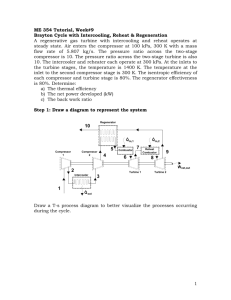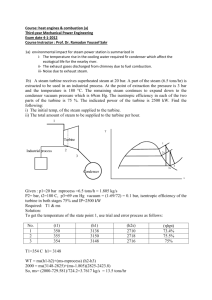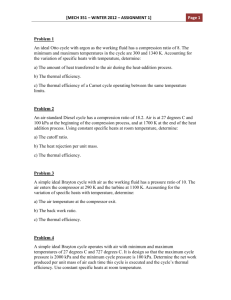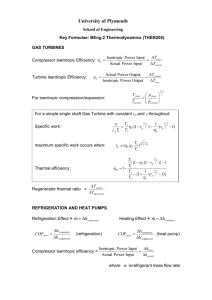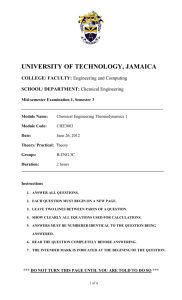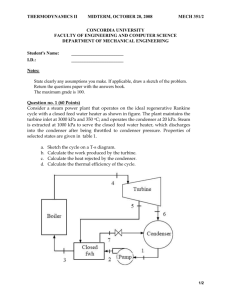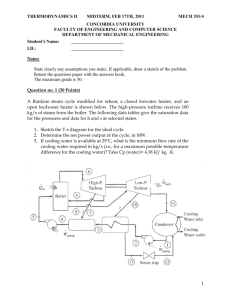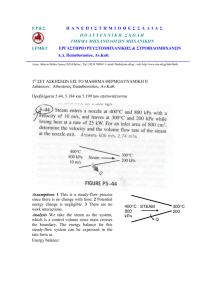ME 354 Tutorial, Week#8
advertisement
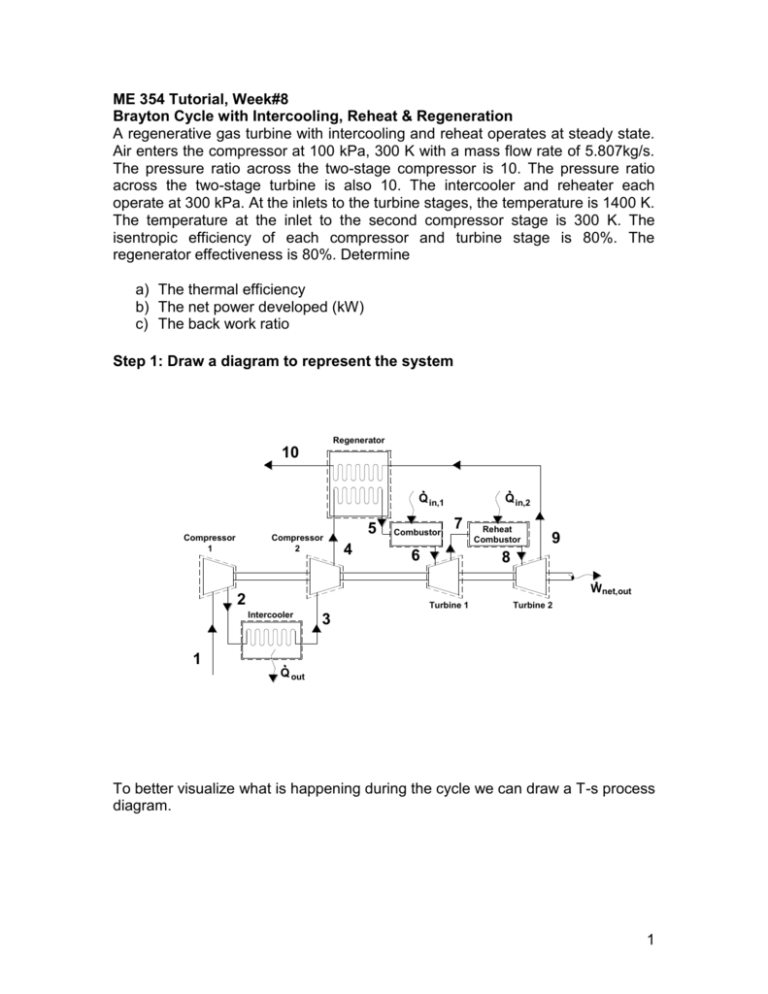
ME 354 Tutorial, Week#8 Brayton Cycle with Intercooling, Reheat & Regeneration A regenerative gas turbine with intercooling and reheat operates at steady state. Air enters the compressor at 100 kPa, 300 K with a mass flow rate of 5.807kg/s. The pressure ratio across the two-stage compressor is 10. The pressure ratio across the two-stage turbine is also 10. The intercooler and reheater each operate at 300 kPa. At the inlets to the turbine stages, the temperature is 1400 K. The temperature at the inlet to the second compressor stage is 300 K. The isentropic efficiency of each compressor and turbine stage is 80%. The regenerator effectiveness is 80%. Determine a) The thermal efficiency b) The net power developed (kW) c) The back work ratio Step 1: Draw a diagram to represent the system Regenerator 10 Q in,1 Compressor 1 Compressor 2 5 4 Combustor Q in,2 7 6 Reheat Combustor 9 8 Wnet,out 2 Turbine 1 Intercooler Turbine 2 3 1 Q out To better visualize what is happening during the cycle we can draw a T-s process diagram. 1 T 6 8 5 7 9 7s 4s 9s 4 10 2 2s 3 1 s Step 2: Prepare a property table 1 2 2s 3 4 4s 5 6 7 7s 8 9 9s 10 T (K) 300 300 1400 1400 P (kPa) 100 300 300 300 1000 1000 1000 1000 300 300 300 100 100 100 Step 3: State your assumptions Assumptions: 1) ke, pe 0 2) air-standard assumptions are applicable 3) air is an ideal gas with constant specific heats at room temperature 4) SSSF 2 Step 4: Calculations Part a) The thermal efficiency of the system can be expressed as the ratio of the sytem’s net-work output to the system’s heat input (we have heat inputs at the combustor AND the reheat combustor) as shown in Eq1. Note: the heat input that occurs from location 4 to 5 is an internal energy transfer, getting its energy from location 9 to 10 and thus does not qualify as a heat input into the system. th wnet ,out qin,1 qin, 2 (Eq1) The wnet,out can be determined from the difference between the work output of the turbines and the work input to the compressors. The work for each of these devices can be determined from energy balances applied to the individual control volumes to obtain Eq2. Note: We have applied the steady operating conditions assumption and the assumption that ke & pe 0 in each of our energy balances. wnet ,out wt ,1 wt , 2 wc ,1 wc , 2 (h6 h7 ) (h8 h9 ) (h2 h1 ) (h4 h3 ) (Eq2) Since we are assuming that air is the working fluid and modeling it as an ideal gas with constant specific heats at room temperature we can rewrite Eq2, applying the ideal gas relation for enthalpy difference between two states [e.g. h 2 - h1=cp(T2-T1)], as shown in Eq3. wnet ,out c p [(T6 T7 ) (T8 T9 )] [(T2 T1 ) (T4 T3 )] (Eq3) The heat input can be determined from energy balances applied to the individual control volumes (combustor and reheat combustor), similarly to what we did in Eq2 & Eq3, to obtain Eq4. qin,1 qin, 2 (h6 h5 ) (h8 h7 ) c p [(T6 T5 ) (T8 T7 )] (Eq4) From Eq3 & Eq4 we can see that we must determine the temperatures of locations 1 through 9 before we can calculate the thermal efficiency. Location 1 T1=300 K (Given compressor 1 inlet conditions) Location 2 We can use the isentropic efficiency of the compressor to determine the temperature at Location 2 as shown in Eq5. 3 c h2 s h1 c p (T2 s T1 ) T T1 T2 T1 2 s h2 h1 c p (T2 T1 ) c (Eq5) To find the temperature at Location 2 from Eq5 we must first determine the temperature at Location 2 if the compression process were isentropic. We can use an ideal gas relation for isentropic processes to find the temperature at state 2s as shown below. T2 s P2 T1 P1 k 1 k 0.4 300[kPa] 1.4 = 410.62 K T2 s 300K 100[kPa] Substituting this back into Eq5 we can solve for the temperature at Location 2. T2 T1 T2 s T1 c 410.62[ K ] 300[ K ] = 438.3 K 0.80 300[ K ] Location 3 T3=300 K (Given compressor 2 inlet conditions) Location 4 Similarly to Location 2, we can use the isentropic efficiency of the compressor to determine the temperature at Location 4, as shown in Eq6. c h4 s h3 c p (T4 s T3 ) T T3 T4 T3 4 s h4 h3 c p (T4 T3 ) c (Eq6) To find the temperature at Location 4 from Eq6 we must first determine the temperature at Location 4 if the compression process was isentropic. We can use the ideal gas relation for isentropic processes to find the temperature at state 4s as shown below. T4 s P4 T3 P3 k 1 k 0.4 1000[kPa] 1.4 = 423.17 K T4 s 300K 300[kPa] Substituting this back into Eq6 we can solve for the temperature at Location 4. T4 T3 T4 s T3 c 300[ K ] 423.2[ K ] 300[ K ] = 453.96 K 0.80 4 Location 5 To find the temperature at Location 5 we can make use of the regenerator’s effectiveness, as shown in Eq7. regen q regen,act q regen,max h5 h4 c p (T5 T4 ) T5 T4 regen (T9 T4 ) h9 h4 c p (T9 T4 ) (Eq7) At this point the temperature at Location 9 is still unknown so we will have to come back to Eq7 once we have determined T 9. Location 6 T6 = 1400 K (Given turbine 1 inlet conditions) Location 7 We can use the isentropic efficiency of the turbine to determine the temperature at Location 7, as shown in Eq8. t c p (T6 T7 ) h6 h7 T7 T6 t (T6 T7 s ) h6 h7 s c p (T6 T7 s ) (Eq8) To find the temperature at Location 7 from Eq8 we must first determine the temperature at Location 7 if the expansion process was isentropic. We can use the ideal gas relation for isentropic processes to find the temperature at state 7s as shown below. T7 s P7 T6 P6 k 1 k 300[kPa] T7 s 1400K 1000[kPa] 0.4 1.4 = 992.51 K Substituting this back into Eq8 we can solve for the temperature at Location 7. T7 T6 t (T6 T7 s ) 1400[ K ] (0.8)(1400[ K ] 992.51[ K ]) = 1074 K Location 8 T8 = 1400 K (Given turbine 2 inlet conditions) Location 9 We can use the isentropic efficiency of the turbine to determine the temperature at Location 9 as shown in Eq9. c p (T8 T9 ) h h t 8 9 T9 T8 t (T8 T9 s ) (Eq9) h8 h9 s c p (T8 T9 s ) 5 To find the temperature at Location 9 from Eq9 we must first determine the temperature at Location 9 if the expansion process was isentropic. We can use the ideal gas relation for isentropic processes to find the temperature at state 9s as shown below. T9 s P9 T8 P8 k 1 k 0.4 100[kPa] 1.4 = 1023 K T9 s 1400K 300[kPa] Substituting this back into Eq9 we can solve for the temperature at Location 9. T9 T8 t (T8 T9 s ) 1400[ K ] (0.8)(1400[ K ] 1023[ K ]) = 1098.3 K Location 5 cont’d We can now go back to Eq7 and solve for the temperature at Location 5. T5 T4 regen (T9 T4 ) 453.96 (0.8)(1098.3 453.96) =969.43 K Our property table is now complete and we can solve for the thermal efficiency. 1 2 2s 3 4 4s 5 6 7 7s 8 9 9s 10 T (K) 300 438.3 410.62 300 453.96 423.2 969.43 1400 1074 992.51 1400 1098.3 1023 P (kPa) 100 300 300 300 1000 1000 1000 1000 300 300 300 100 100 100 Substituting Eq3 and Eq4 into Eq1 we can solve for the thermal efficiency. 6 th (T6 T7 ) (T8 T9 ) (T2 T1 ) (T4 T3 ) (326) (301.7) (138.3) (153.96) (T6 T5 ) (T8 T7 ) th 627.7 292.26 =0.443 or 44.3% 756.57 (430.57) (326) Answer a) Part b) The net power developed with be the wnet,out (Eq3) multiplied by the mass flow rate of air. We are given the mass flow rate of air in the problem statement as being 5.807 kg/s. kJ W net ,out m air wnet ,out (5.807[kg / s])1.005 627.7[ K ] 292.26K kg K =1957.6 kW Answer b) Part c) The back work ratio is defined as the ratio of compressor work to the turbine work. bwr wc ,in wt ,out 292.26 =0.466 or 46.6% 627.7 Answer c) Step 5: Concluding Remarks & Discussion a) The thermal efficiency was calculated as 0.443. b) The net power developed is 1957.6 kW. c) The back work ratio is 0.466. 7
